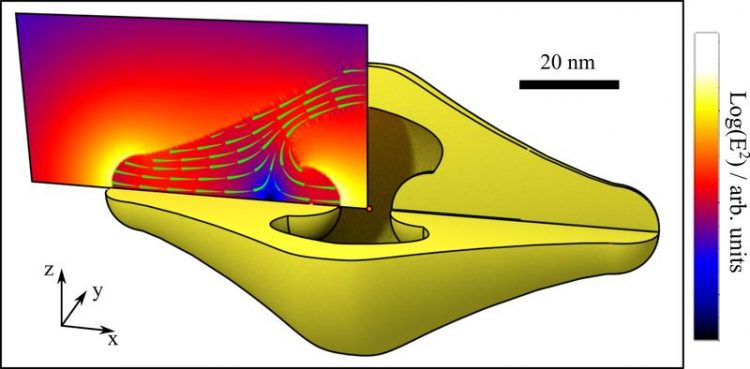Midwife and signpost for photons

Sketch of an optimized optical antenna: A cavity is located inside; the electrical fields during operation are coded by the colour scale. Current patterns are represented by green arrows. Picture: Thorsten Feichtner
Atoms and molecules can be made to emit light particles (photons). However, without external intervention this process is inefficient and undirected.
If it was possible to influence the process of photon creation fundamentally in terms of efficiency and emission direction, new technical possibilities would be opened up such as tiny, multifunctional light pixels that could be used to build three-dimensional displays or reliable single-photon sources for quantum computers or optical microscopes to map individual molecules.
Nanometre-sized “optical antennas” are a well-known approach. They are capable of sending photons in a specific direction with high efficiency. The idea goes back to Nobel Laureate Richard P. Feynman who envisioned nanoscale antennas during a speech at the California Institute of Technology already in 1959.
Feynman was way ahead of his time, but he triggered a rapid development in nanotechnology which enables building antenna for visible light today. The dimensions and structural details of such antennas can be controlled precisely at a size of around 250 nanometres.
The deficits of existing light antennas
The form of these optical antennas has previously been inspired by established models from radio communication and radio technology. The antennas used there are usually made of specially shaped metal wires and metal rod arrays due to the wavelengths in the centimetre range. It is in fact possible to construct antennas for light waves using metal nanorods to influence the creation and propagation of photons, but the analogy between radio waves and light waves is limited.
While macroscopic radio antennas have a high-frequency generator connected to the antenna via cable, the link at the nanometre scale of a light wave length has to be contactless. But atoms and molecules that act as photon sources do not feature connecting cables to hook them up to an optical antenna.
It is this major difference, combined with a number of other problems that are due to the high frequency of light, that has made it impossible so far to produce and subsequently control photons with optical antennas in a satisfactory manner.
Publication in the journal “Physical Review Letters”
Physicists from Julius-Maximilians-Universität (JMU) Würzburg in Bavaria, Germany, have now solved this problem and established a set of rules for optimized optical antennas which were published in the prestigious journal “Physical Review Letters”.
The new rules could help build antennas for light so that both the photons' birth and their subsequent propagation can be controlled precisely, at least theoretically, according to Thorsten Feichtner, a researcher at JMU’s Institute of Physics in Professor Bert Hecht's team.
The principle behind the new antennas
“The idea behind this is based on the principle of similarity,” the Würzburg physicist explains. “What's new in our research is that the currents of the free electrons in the antenna have to fulfil two similarity conditions at the same time. Firstly, the current pattern in the antenna must be similar to the field lines in the direct vicinity of a light-emitting atom or molecule. Secondly, the current pattern must also match the homogeneous electrical field of a plane wave as best as possible so that each photon can reach a distant receiver.”
The novel antennas for light built with the help of these new rules extract far more photons from an emitter than previous antenna types derived from radio technology.
Feichtner, T., Christiansen, S., & Hecht, B. (2017). Mode Matching for Optical Antennas. Physical Review Letters, 119(21), 217401, 21 November 2017, DOI: https://doi.org/10.1103/PhysRevLett.119.217401
Contact
Thorsten Feichtner, Institute of Physics, JMU, T +49 931 31-85768, thorsten.feichtner@physik.uni-wuerzburg.de
Media Contact
More Information:
http://www.uni-wuerzburg.deAll latest news from the category: Physics and Astronomy
This area deals with the fundamental laws and building blocks of nature and how they interact, the properties and the behavior of matter, and research into space and time and their structures.
innovations-report provides in-depth reports and articles on subjects such as astrophysics, laser technologies, nuclear, quantum, particle and solid-state physics, nanotechnologies, planetary research and findings (Mars, Venus) and developments related to the Hubble Telescope.
Newest articles

Properties of new materials for microchips
… can now be measured well. Reseachers of Delft University of Technology demonstrated measuring performance properties of ultrathin silicon membranes. Making ever smaller and more powerful chips requires new ultrathin…

Floating solar’s potential
… to support sustainable development by addressing climate, water, and energy goals holistically. A new study published this week in Nature Energy raises the potential for floating solar photovoltaics (FPV)…

Skyrmions move at record speeds
… a step towards the computing of the future. An international research team led by scientists from the CNRS1 has discovered that the magnetic nanobubbles2 known as skyrmions can be…





















